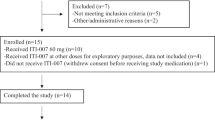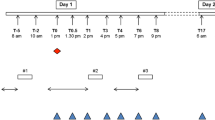Abstract
Quetiapine (Seroquel) is a novel antipsychotic with an atypical profile in animal models and a relatively short plasma half-life of 2.5–5 h. In the present study, we used PET to compare the time course of blockade of dopamine D2 and serotonin 5HT2 receptors of quetiapine using C11-raclopride and C11-N-methyl-spiperone as ligands, parallel to monitoring plasma drug concentrations. It was an open study in 11 schizophrenic men using a fixed dose of 450 mg quetiapine. Eight men completed the 29 days treatment, followed by four PET scans performed over a 26-h period after withdrawal of the compound. Quetiapine was shown to bind to dopamine D2 receptors in striatum and 2 h (tmax) after the last dose, 44% receptor occupancy was calculated. After 26 h it had dropped to the same level as was found in untreated healthy volunteers. Serotonin 5HT2 receptor blockade in the frontal cortex was 72% after 2 h, which declined to 50% after 26 h. The terminal plasma half-life of quetiapine was 5.3 h. Clinically, our eight patients had good antipsychotic effect without any extrapyramidal side-effects. Our data shows that quetiapine has a relatively low affinity for dopamine D2 receptors, with an occupancy half-life (10 h), which was about twice as long as that for plasma. A more prolonged blockade of the serotonin 5HT2 receptors was found in the frontal cortex, with receptor occupancy half-life of 27 h. Compared to clozapine, as demonstrated in other studies, quetiapine has much the same ratio of D2/5HT2 occupancy. This could suggest that the combination of D2/5HT2 receptor blockade contributes to the antipsychotic effect and a low incidence of EPS seen with quetiapine in comparative phase three trials. Our results also confirm the clinical data that quetiapine can be administered twice daily.
Similar content being viewed by others
Author information
Authors and Affiliations
Additional information
Received: 13 December 1996/Final version: 13 June 1997
Rights and permissions
About this article
Cite this article
Gefvert, O., Bergström, M., Långström, B. et al. Time course of central nervous dopamine-D2 and 5-HT2 receptor blockade and plasma drug concentrations after discontinuation of quetiapine (Seroquel®) in patients with schizophrenia. Psychopharmacology 135, 119–126 (1998). https://doi.org/10.1007/s002130050492
Issue Date:
DOI: https://doi.org/10.1007/s002130050492




